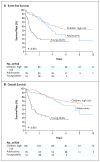Targetable kinase-activating lesions in Ph-like acute lymphoblastic leukemia
- PMID: 25207766
- PMCID: PMC4191900
- DOI: 10.1056/NEJMoa1403088
Targetable kinase-activating lesions in Ph-like acute lymphoblastic leukemia
Abstract
Background: Philadelphia chromosome-like acute lymphoblastic leukemia (Ph-like ALL) is characterized by a gene-expression profile similar to that of BCR-ABL1-positive ALL, alterations of lymphoid transcription factor genes, and a poor outcome. The frequency and spectrum of genetic alterations in Ph-like ALL and its responsiveness to tyrosine kinase inhibition are undefined, especially in adolescents and adults.
Methods: We performed genomic profiling of 1725 patients with precursor B-cell ALL and detailed genomic analysis of 154 patients with Ph-like ALL. We examined the functional effects of fusion proteins and the efficacy of tyrosine kinase inhibitors in mouse pre-B cells and xenografts of human Ph-like ALL.
Results: Ph-like ALL increased in frequency from 10% among children with standard-risk ALL to 27% among young adults with ALL and was associated with a poor outcome. Kinase-activating alterations were identified in 91% of patients with Ph-like ALL; rearrangements involving ABL1, ABL2, CRLF2, CSF1R, EPOR, JAK2, NTRK3, PDGFRB, PTK2B, TSLP, or TYK2 and sequence mutations involving FLT3, IL7R, or SH2B3 were most common. Expression of ABL1, ABL2, CSF1R, JAK2, and PDGFRB fusions resulted in cytokine-independent proliferation and activation of phosphorylated STAT5. Cell lines and human leukemic cells expressing ABL1, ABL2, CSF1R, and PDGFRB fusions were sensitive in vitro to dasatinib, EPOR and JAK2 rearrangements were sensitive to ruxolitinib, and the ETV6-NTRK3 fusion was sensitive to crizotinib.
Conclusions: Ph-like ALL was found to be characterized by a range of genomic alterations that activate a limited number of signaling pathways, all of which may be amenable to inhibition with approved tyrosine kinase inhibitors. Trials identifying Ph-like ALL are needed to assess whether adding tyrosine kinase inhibitors to current therapy will improve the survival of patients with this type of leukemia. (Funded by the American Lebanese Syrian Associated Charities and others.).
Figures



Comment in
-
A call to action for acute lymphoblastic leukemia.N Engl J Med. 2014 Sep 11;371(11):1064-6. doi: 10.1056/NEJMe1407477. N Engl J Med. 2014. PMID: 25207770 No abstract available.
-
Ph-like acute lymphoblastic leukemia in older adults.N Engl J Med. 2014 Dec 4;371(23):2235. doi: 10.1056/NEJMc1412123#SA1. N Engl J Med. 2014. PMID: 25470705 No abstract available.
References
-
- Stock W. Adolescents and young adults with acute lymphoblastic leukemia. Hematology Am Soc Hematol Educ Program. 2010;2010:21–9. - PubMed
Publication types
MeSH terms
Substances
Grants and funding
- U10 CA180861/CA/NCI NIH HHS/United States
- R37 CA36401/CA/NCI NIH HHS/United States
- U10 CA014958/CA/NCI NIH HHS/United States
- U10 CA021115/CA/NCI NIH HHS/United States
- U01 CA157937-01/CA/NCI NIH HHS/United States
- R37 CA036401/CA/NCI NIH HHS/United States
- U10 CA101140/CA/NCI NIH HHS/United States
- P30 CA021765/CA/NCI NIH HHS/United States
- U01 CA157937/CA/NCI NIH HHS/United States
- U10 CA098543/CA/NCI NIH HHS/United States
- NIGMS 92666/PHS HHS/United States
- U10 CA180899/CA/NCI NIH HHS/United States
- P30 CA016672/CA/NCI NIH HHS/United States
- U24-CA114737/CA/NCI NIH HHS/United States
- U10 CA98413/CA/NCI NIH HHS/United States
- CA14958/CA/NCI NIH HHS/United States
- RC2 CA148529/CA/NCI NIH HHS/United States
- R25 CA023944/CA/NCI NIH HHS/United States
- CA145707/CA/NCI NIH HHS/United States
- U10 CA098413/CA/NCI NIH HHS/United States
- F32 CA141762/CA/NCI NIH HHS/United States
- U24 CA114766/CA/NCI NIH HHS/United States
- U10 CA21115/CA/NCI NIH HHS/United States
- RC1 CA145707/CA/NCI NIH HHS/United States
- U10 CA180820/CA/NCI NIH HHS/United States
- U24 CA114737/CA/NCI NIH HHS/United States
- T32 CA128583/CA/NCI NIH HHS/United States
- CA 21765/CA/NCI NIH HHS/United States
- U10 CA180886/CA/NCI NIH HHS/United States
- HHSN261200800001E/CA/NCI NIH HHS/United States
- U10 CA98543/CA/NCI NIH HHS/United States
- U01 GM092666/GM/NIGMS NIH HHS/United States
- U10 CA180827/CA/NCI NIH HHS/United States
LinkOut - more resources
Full Text Sources
Other Literature Sources
Medical
Molecular Biology Databases
Miscellaneous
